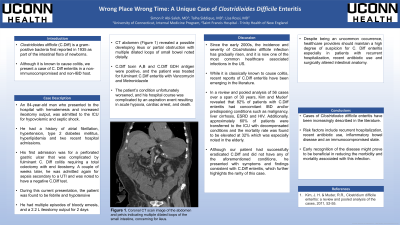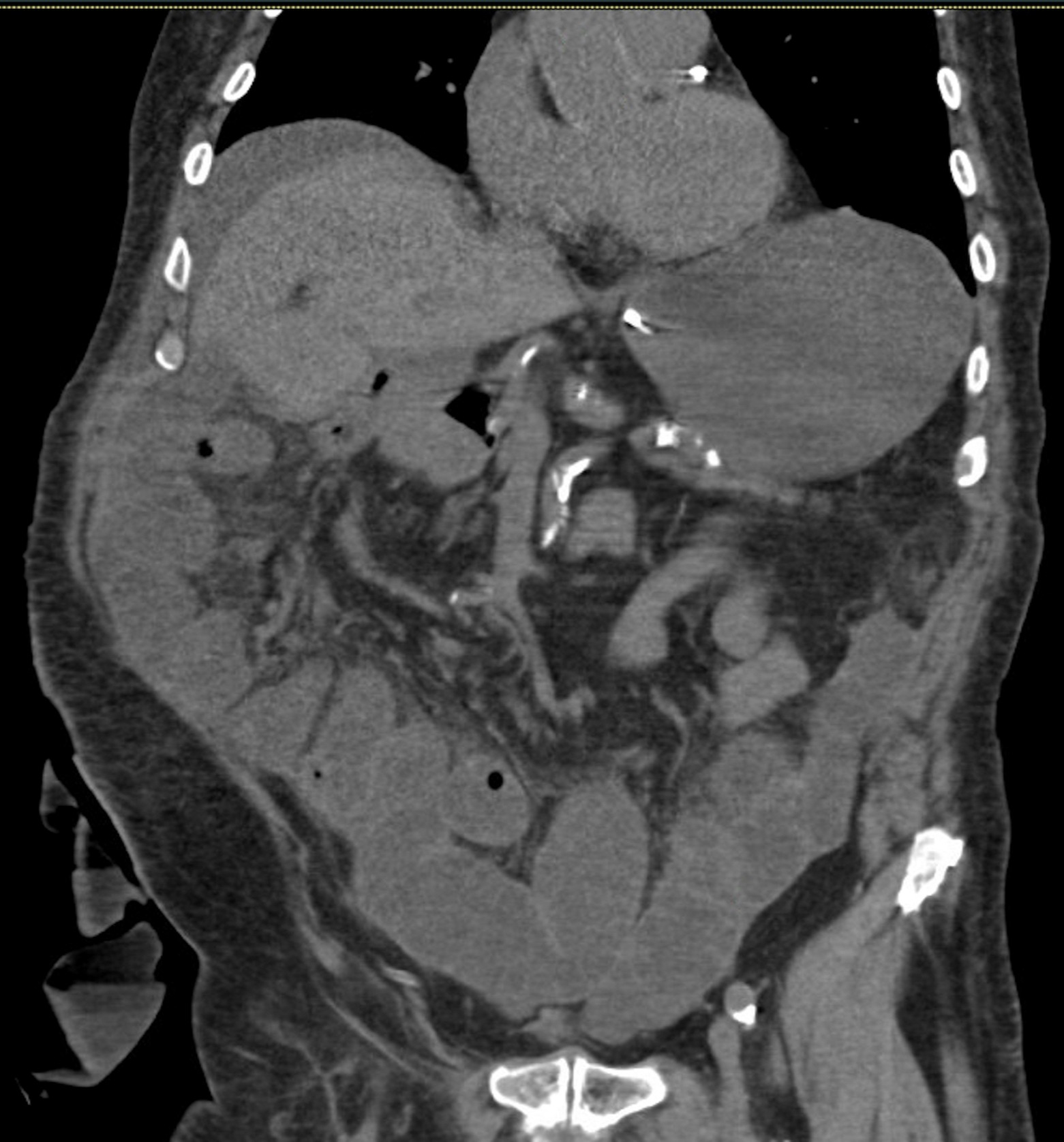Sunday Poster Session
Category: Small Intestine
P1315 - Wrong Place Wrong Time: A Unique Case of Clostridioides Difficile Enteritis
Sunday, October 22, 2023
3:30 PM - 7:00 PM PT
Location: Exhibit Hall

Has Audio

Simon P. Abi-Saleh, MD
UCONN Health
Hartford, CT
Presenting Author(s)
Simon P. Abi-Saleh, MD1, Talha M. Siddique, MD1, Lisa Rossi, MD2
1UCONN Health, Hartford, CT; 2Saint Francis Hospital-Trinity Health of New England, Hartford, CT
Introduction: Clostridioides difficile (C.Diff) is a gram positive bacteria first reported in 1935 as part of the intestinal flora of newborns. Although it is known to cause colitis, we present a case of C.Diff enteritis in a non-immunocompromised and non-IBD host.
Case Description/Methods: An 84 year old man who presented to the hospital with hematemesis and increased ileostomy output, was admitted to the ICU for hypovolemic and septic shock. He had a history of atrial fibrillation, hypertension, type 2 diabetes mellitus, hyperlipidemia and two recent hospital admissions. His first admission was for a perforated gastric ulcer that was complicated by fulminant C.Diff colitis requiring a total colectomy with end ileostomy. A couple of weeks later, he was admitted for sepsis secondary to UTI and was noted to have a negative C.Diff test. During this current presentation, the patient was found to be febrile and hypotensive. He had multiple episodes of bloody emesis, and a 2.2 L ileostomy output for 2 days. CT abdomen revealed a possible developing ileus or partial obstruction with multiple dilated loops of small bowel noted distally. C.Diff toxin A,B and C.Diff GDH antigen were positive, and the patient was treated for fulminant C.Diff enteritis with Vancomycin and Metronidazole. The patient's hospital course was complicated by an aspiration event resulting in acute hypoxia, cardiac arrest, and death.
Discussion: Since the early 2000s, the incidence and severity of C.Diff infection has gradually risen, and it is now one of the most common healthcare associated infections in the US. While it is classically known to cause colitis, recent reports of C.Diff enteritis have been emerging in the literature. In a review and pooled analysis of 56 cases over a span of 30 years, Kim and Muder1 revealed that 82% of patients with C.Diff enteritis had concomitant IBD and/or predisposing conditions such as malignancy, liver cirrhosis, ESRD and HIV. Although our patient had successfully eradicated C.Diff and did not have any of the aforementioned conditions, he presented with symptoms and findings consistent with C.Diff enteritis, highlighting the rarity of this case. Despite being an uncommon occurrence, healthcare providers should maintain a degree of suspicion in patients with surgically altered intestinal anatomy in order to reduce the morbidity and mortality associated with this infection.
References
Kim, J. H. & Muder, R.R., Clostridium difficile enteritis: a review and pooled analysis of the cases, 2011, 52-55.

Disclosures:
Simon P. Abi-Saleh, MD1, Talha M. Siddique, MD1, Lisa Rossi, MD2. P1315 - Wrong Place Wrong Time: A Unique Case of Clostridioides Difficile Enteritis, ACG 2023 Annual Scientific Meeting Abstracts. Vancouver, BC, Canada: American College of Gastroenterology.
1UCONN Health, Hartford, CT; 2Saint Francis Hospital-Trinity Health of New England, Hartford, CT
Introduction: Clostridioides difficile (C.Diff) is a gram positive bacteria first reported in 1935 as part of the intestinal flora of newborns. Although it is known to cause colitis, we present a case of C.Diff enteritis in a non-immunocompromised and non-IBD host.
Case Description/Methods: An 84 year old man who presented to the hospital with hematemesis and increased ileostomy output, was admitted to the ICU for hypovolemic and septic shock. He had a history of atrial fibrillation, hypertension, type 2 diabetes mellitus, hyperlipidemia and two recent hospital admissions. His first admission was for a perforated gastric ulcer that was complicated by fulminant C.Diff colitis requiring a total colectomy with end ileostomy. A couple of weeks later, he was admitted for sepsis secondary to UTI and was noted to have a negative C.Diff test. During this current presentation, the patient was found to be febrile and hypotensive. He had multiple episodes of bloody emesis, and a 2.2 L ileostomy output for 2 days. CT abdomen revealed a possible developing ileus or partial obstruction with multiple dilated loops of small bowel noted distally. C.Diff toxin A,B and C.Diff GDH antigen were positive, and the patient was treated for fulminant C.Diff enteritis with Vancomycin and Metronidazole. The patient's hospital course was complicated by an aspiration event resulting in acute hypoxia, cardiac arrest, and death.
Discussion: Since the early 2000s, the incidence and severity of C.Diff infection has gradually risen, and it is now one of the most common healthcare associated infections in the US. While it is classically known to cause colitis, recent reports of C.Diff enteritis have been emerging in the literature. In a review and pooled analysis of 56 cases over a span of 30 years, Kim and Muder1 revealed that 82% of patients with C.Diff enteritis had concomitant IBD and/or predisposing conditions such as malignancy, liver cirrhosis, ESRD and HIV. Although our patient had successfully eradicated C.Diff and did not have any of the aforementioned conditions, he presented with symptoms and findings consistent with C.Diff enteritis, highlighting the rarity of this case. Despite being an uncommon occurrence, healthcare providers should maintain a degree of suspicion in patients with surgically altered intestinal anatomy in order to reduce the morbidity and mortality associated with this infection.
References
Kim, J. H. & Muder, R.R., Clostridium difficile enteritis: a review and pooled analysis of the cases, 2011, 52-55.

Figure: Coronal CT scan image of the abdomen and pelvis indicating multiple dilated loops of the small intestine, concerning for ileus.
Disclosures:
Simon Abi-Saleh indicated no relevant financial relationships.
Talha Siddique indicated no relevant financial relationships.
Lisa Rossi indicated no relevant financial relationships.
Simon P. Abi-Saleh, MD1, Talha M. Siddique, MD1, Lisa Rossi, MD2. P1315 - Wrong Place Wrong Time: A Unique Case of Clostridioides Difficile Enteritis, ACG 2023 Annual Scientific Meeting Abstracts. Vancouver, BC, Canada: American College of Gastroenterology.
